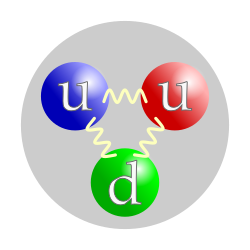
In physics, a subatomic particle is a particle smaller than an atom. [1] According to the Standard Model of particle physics, a subatomic particle can be either a composite particle, which is composed of other particles (for example, a baryon, like a proton or a neutron, composed of three quarks; or a meson, composed of two quarks), or an elementary particle, which is not composed of other particles (for example, quarks; or electrons, muons, and tau particles, which are called leptons). [2] Particle physics and nuclear physics study these particles and how they interact. [3] Most force-carrying particles like photons or gluons are called bosons and, although they have quanta of energy, do not have rest mass or discrete diameters (other than pure energy wavelength) and are unlike the former particles that have rest mass and cannot overlap or combine which are called fermions. The W and Z bosons, however, are an exception to this rule and have relatively large rest masses at approximately 80 GeV/c2 and 90 GeV/c2 respectively.
Contents
- Classification
- By composition
- By statistics
- By mass
- By decay
- Other properties
- Dividing an atom
- History
- See also
- References
- Further reading
- General readers
- Textbooks
- External links
Experiments show that light could behave like a stream of particles (called photons) as well as exhibiting wave-like properties. This led to the concept of wave–particle duality to reflect that quantum-scale particles behave both like particles and like waves; they are occasionally called wavicles to reflect this. [4]
Another concept, the uncertainty principle, states that some of their properties taken together, such as their simultaneous position and momentum, cannot be measured exactly. [5] Interactions of particles in the framework of quantum field theory are understood as creation and annihilation of quanta of corresponding fundamental interactions. This blends particle physics with field theory.
Even among particle physicists, the exact definition of a particle has diverse descriptions. These professional attempts at the definition of a particle include: [6]
- A particle is a collapsed wave function
- A particle is an excitation of a quantum field
- A particle is an irreducible representation of the Poincaré group
- A particle is an observed thing
| Subatomic particle | Symbol | Type | Location in atom | Charge [ e ] | Mass [ Da ] |
|---|---|---|---|---|---|
| proton | p+ | composite | nucleus | +1 | ≈ 1 |
| neutron | n0 | composite | nucleus | 0 | ≈ 1 |
| electron | e− | elementary | shells | −1 | ≈ 1/2000 |

